trailer BUICK CENTURY 1996 Owners Manual
[x] Cancel search | Manufacturer: BUICK, Model Year: 1996, Model line: CENTURY, Model: BUICK CENTURY 1996Pages: 340, PDF Size: 17.61 MB
Page 68 of 340
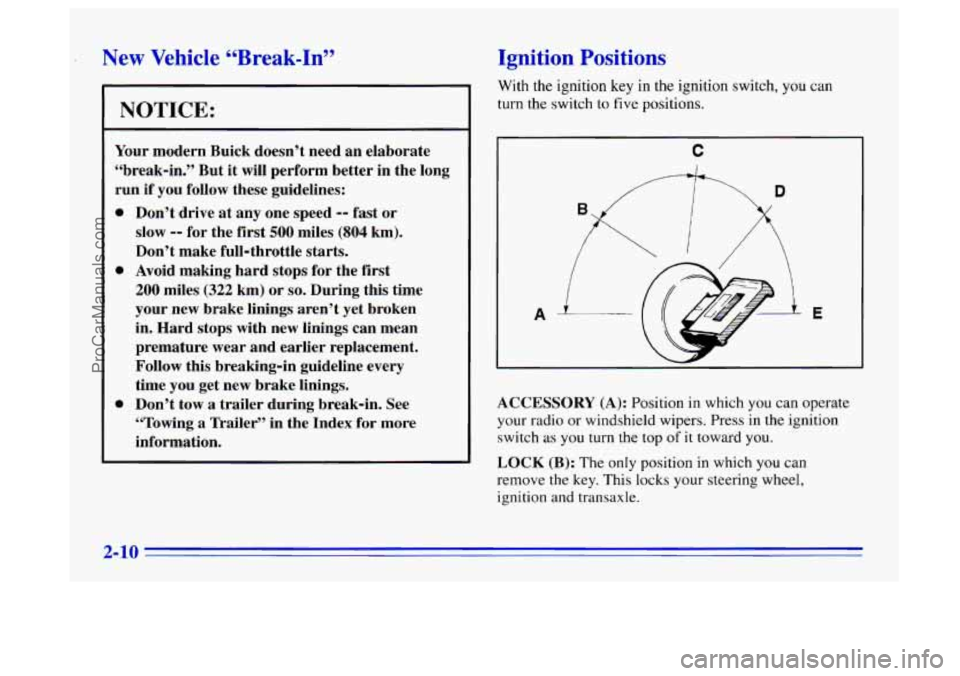
’ New Vehicle “Break-In”
NOTICE:
Your modern Buick doesn’t need an elaborate
“break-in.” But it will perform better in the long
run if you follow these guidelines:
0
0
0
Don’t drive at any one speed -- fast or
slow
-- for the first 500 miles (804 km).
Don’t make full-throttle starts.
Avoid making hard stops for the first
200 miles (322 km) or so. During this time
your new brake linings aren’t yet broken
in. Hard stops with new linings can mean
premature wear and earlier replacement.
Follow this breaking-in guideline every
time you get new brake linings.
Don’t tow
a trailer during break-in. See
“Towing a Trailer” in the Index
for more
information.
Ignition Positions
With the ignition key in the ignition switch, you can
turn the switch
to five positions.
C
ACCESSORY (A): Position in which you can operate
your radio or windshield wipers. Press in the ignition
switch as you turn the top
of it toward you.
LOCK (B): The only position in which you can
remove the key.
This locks your steering wheel,
ignition and transaxle.
2-10
ProCarManuals.com
Page 74 of 340
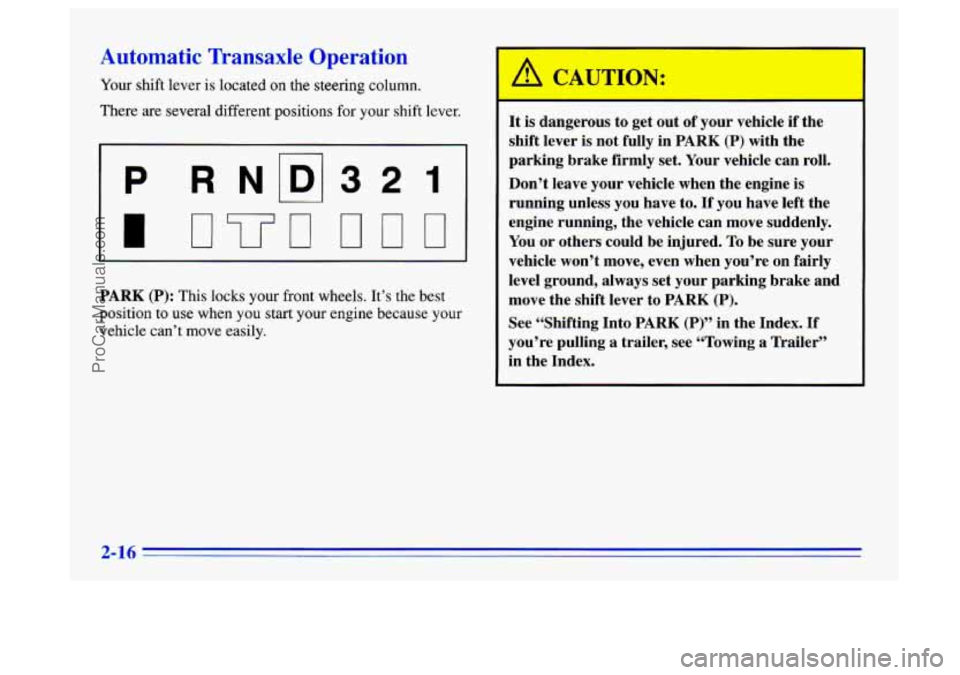
Automatic Transaxle Operation
Your shift lever is located on the steering column.
There are several different positions for your shift lever.
P RNpl321
I I
PARK (P): This locks your front wheels. It’s the best
position to use when you start your engine because your
vehicle can’t move easily.
A CAUTION:
I
It is dangerous to get out of your vehicle if the
shift lever is not fully in
PARK (P) with the
parking brake firmly set. Your vehicle can roll.
Don’t leave your vehicle when the engine is
running unless you have to. If you have left the
engine running, the vehicle can move suddenly.
You or others could be injured.
To be sure your
vehicle won’t move, even when you’re
on fairly
level ground, always set your parking brake and
move the shift lever to
PARK (P).
See “Shifting Into PARK (P)” in the Index. If
you’re pulling
a trailer, see “Towing a Trailer”
in the Index.
2-16
ProCarManuals.com
Page 76 of 340
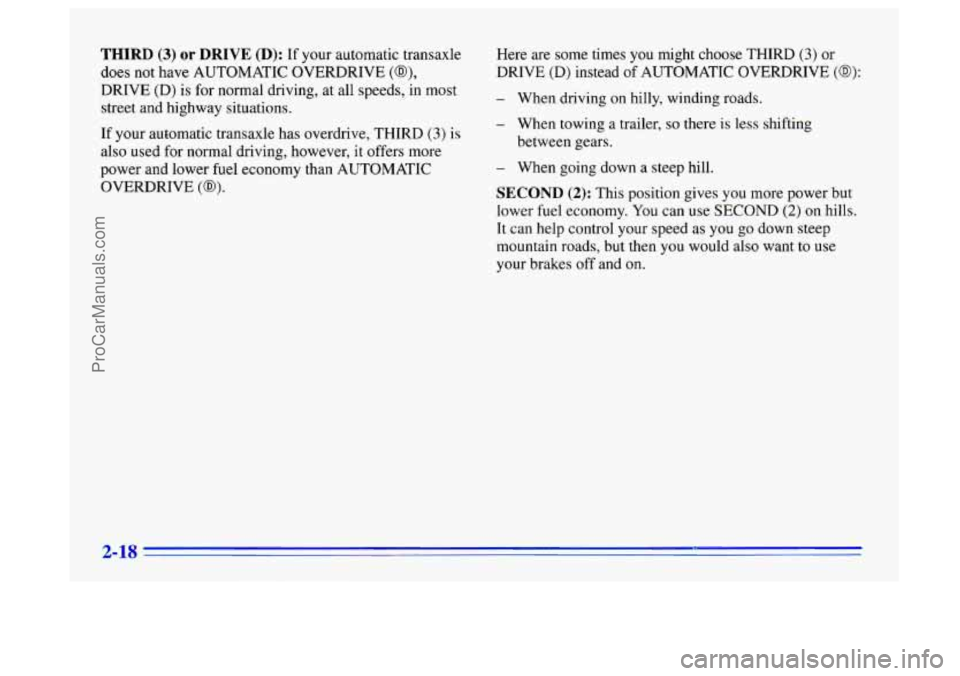
THIRD (3) or DRIVE (D): If your automatic transaxle
does not have AUTOMATIC OVERDRIVE
(@),
DRIVE (D) is for normal driving, at all speeds, in most
street and highway situations.
If your automatic transaxle has overdrive, THIRD
(3) is
also used for normal driving, however, it offers more
power and lower fuel economy than AUTOMATIC
OVERDRIVE
(a).
Here are some times you might choose THRD (3) or
DRIVE
(D) instead of AUTOMATIC OVERDRIVE (a):
- When driving on hilly, winding roads.
- When towing a trailer, so there is less shifting
between gears.
- When going down a steep hill.
SECOND (2): This position gives you more power but
lower fuel economy.
You can use SECOND (2) on hills.
It can help control your speed as you go down steep
mountain roads, but then
you would also want to use
your brakes off and on.
2-18
ProCarManuals.com
Page 78 of 340
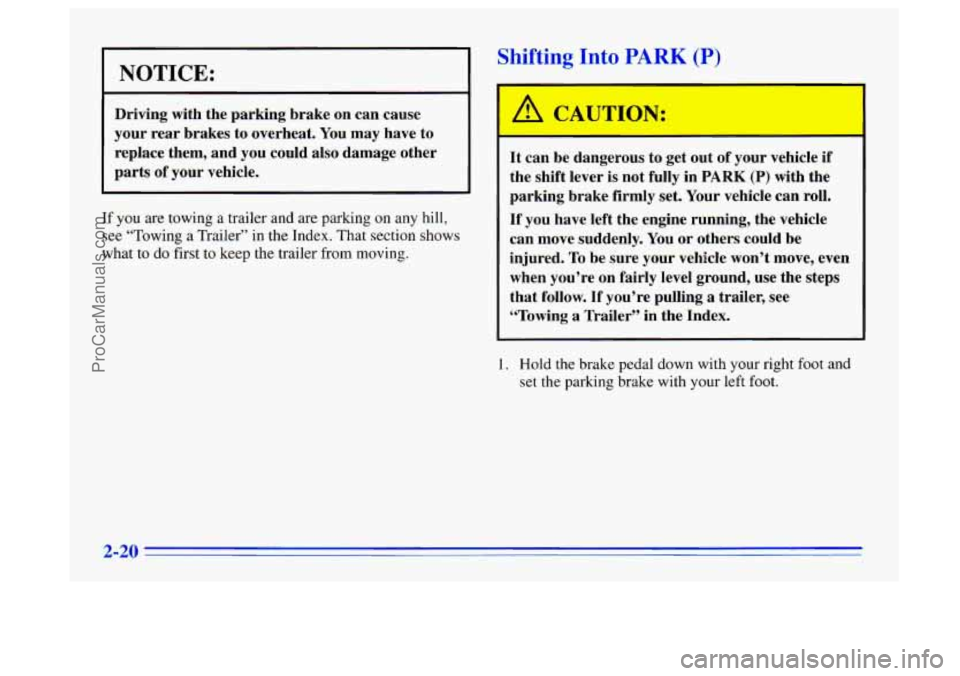
NOTICE:
Driving with the parking brake on can cause
your rear brakes to overheat.
You may have to
replace them, and you could also damage other
parts
of vour vehicle.
If you are towing a trailer and are parking on any hill,
see “Towing a Trailer” in the Index. That section shows
what to do first to keep the trailer from moving.
Shifti 3 In’ PAnK (P)
4
It can be dangerous to get out of your vehicle if‘
the shift lever is not fully in PARK (P) with the
parking brake
firmly set. Your vehicle can roll.
If you have left the engine running, the vehicle
can move suddenly.
You or others could be
injured.
To be sure your vehicle won’t move, even
when you’re on fairly level ground, use the steps
that
follow. If you’re pulling a trailer, see
“Towing
a Trailer” in the Index.
~
1. Hold the brake pedal down with your right foot and
set the parking brake with
your left foot.
2-20
ProCarManuals.com
Page 83 of 340
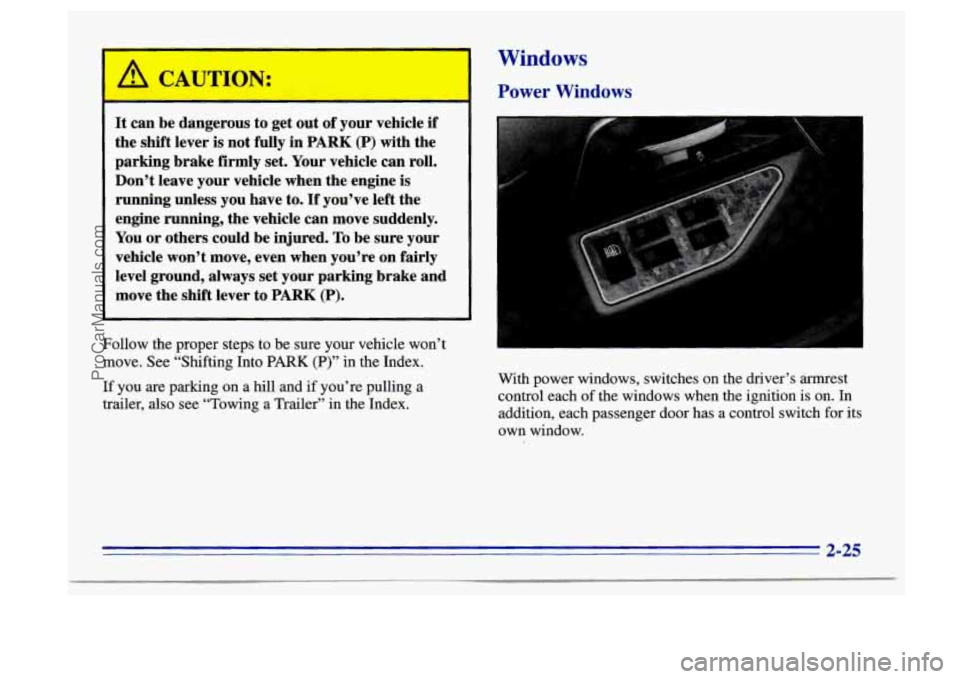
-
A CAUTION:
It can be dangerous to get out of your vehicle if
the shift lever is not fully in PARK (P) with the
parking brake firmly set. Your vehicle can roll.
Don’t leave your vehicle when the engine
is
running unless you have to. If you’ve left the
engine running, the vehicle can move suddenly.
You or others could be injured.
To be sure your
vehicle won’t move, even when you’re on
fairly
level ground, always set your parking brake and
move the shift lever to PARK
(P).
Follow the proper steps to be sure your vehicle won’t
move. See “Shifting Into
PARK (P)” in the Index.
If you are parking on
a hill and if you’re pulling a
trailer, also see “Towing a Trailer” in the Index.
Windows
Power Windows
With power windows, switches on the driver’s armrest
control each of the windows when the ignition is on. In
addition, each passenger door has a control switch for its
own window.
2-25
ProCarManuals.com
Page 114 of 340
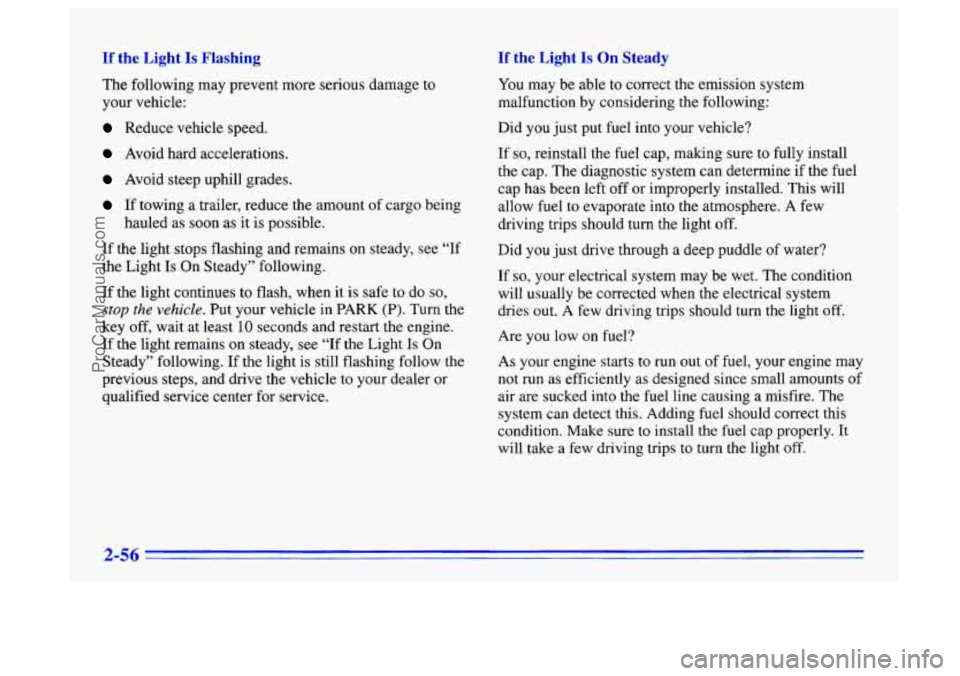
If the Light Is Flashing If the Light Is On Steady
The following may prevent more serious damage to
your vehicle:
Reduce vehicle speed.
Avoid hard accelerations.
Avoid steep uphill grades.
If towing a trailer, reduce the amount of cargo being
hauled as soon
as it is possible.
If the light stops flashing and remains on steady, see
“If
the Light Is On Steady” following.
If the light continues to flash, when it is safe to do
so,
stop the vehicle. Put your vehicle in PARK (P). Turn the
key off, wait at least
10 seconds and restart the engine.
If the light remains on steady, see “If the Light
Is On
Steady” following. If the light
is still flashing follow the
previous steps, and drive the vehicle
to your dealer or
qualified service center for service. You
may be able to correct the emission system
malfunction by considering the following:
Did you just put fuel into your vehicle?
If
so, reinstall the fuel cap, making sure to fully install
the cap. The diagnostic system can determine if the fuel
cap has been left off or improperly installed. This will
allow fuel to evaporate into the atmosphere. A few
driving trips should turn the light off.
Did you just drive through a deep puddle
of water?
If
so, your electrical system may be wet. The condition
will usually be corrected when the electrical system
dries out. A few driving trips should turn the light
off.
Are you low on fuel?
As your engine starts to run out of fuel, your engine may
not run as efficiently
as designed since small amounts of
air are sucked into the
fuel line causing a misfire. The
system can detect this. Adding fuel should correct this
condition. Make sure to install the fuel
cap properly. It
will take a few driving trips to turn the light off.
ProCarManuals.com
Page 160 of 340
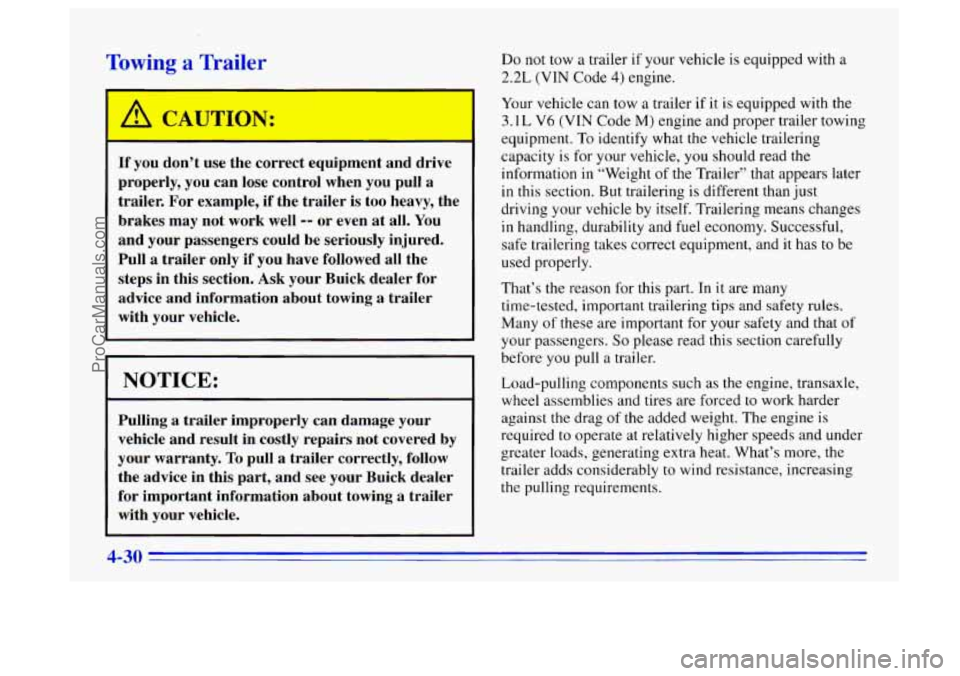
lg a Trailer Do not tow a trailer if your vehicle is equipped with a
2.2L (VIN Code 4) engine.
A CAUTION:
If you don’t use the correct equipment and drive
properly, you can lose control when you pull a
trailer.
For example, if the trailer is too heavy, the
brakes may not work
well -- or even at all. You
and your passengers could be seriously injured.
Pull
a trailer only if you have followed all the
steps in this section. Ask your Buick dealer for
advice and information about towing
a trailer
with your vehicle.
NOTICE:
Pulling a trailer improperly can damage your
vehicle and result in costly repairs not covered by
your warranty.
To pull a trailer correctly, follow
the advice in this part, and see your Buick dealer
for important information about towing a trailer
with your vehicle. Your
vehicle can tow
a trailer if it is equipped with the
3.1L V6 (VTN Code M) engine and proper trailer towing
equipment.
To identify what the vehicle trailering
capacity
is for your vehicle, you should read the
information
in “Weight of the Trailer” that appears later
in this section. But trailering is different than just
driving your vehicle by itself. Trailering means changes
in handling, durability and fuel economy. Successful,
safe trailering takes correct equipment, and it has to be
used properly.
That’s the reason for this part. In
it are many
time-tested, important trailering tips
and safety rules.
Many of these are important for your safety and that
of
your passengers. So please read this section carefully
before you pull
a trailer.
Load-pulling components such
as the engine, transaxle,
wheel assemblies and tires are forced to work harder
against the drag of the added weight. The engine is
required to operate
at relatively higher speeds and under
greater loads, generating extra heat. What’s more, the
trailer adds considerably to wind resistance, increasing
the pulling requirements.
ProCarManuals.com
Page 161 of 340
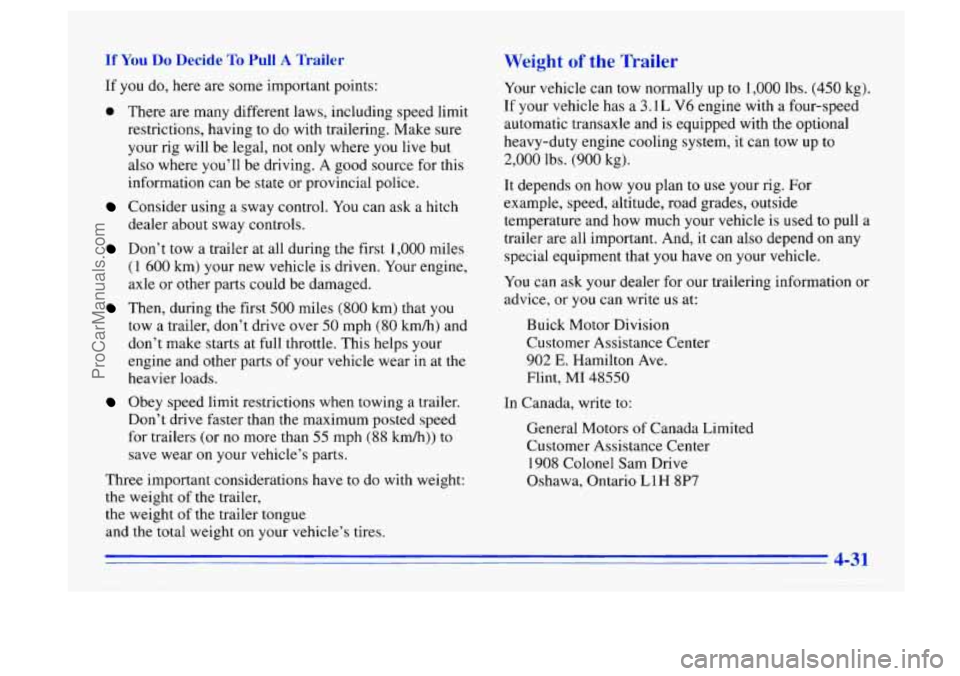
If You Do Decide To Pull A Trailer
If you do, here are some important points:
e There are many different laws, including speed limit
restrictions, having to do with trailering. Make sure
your rig will be legal, not only where you live but
also where you’ll be driving. A good source for this
information can be state or provincial police.
Consider using a sway control. You can ask a hitch
dealer about sway controls.
Don’t tow a trailer at all during the first 1,000 miles
(1 600 km) your new vehicle is driven. Your engine,
axle or other parts could be damaged.
Then, during the first 500 miles (800 km) that you
tow a trailer, don’t drive over
50 mph (80 kmh) and
don’t make starts at full throttle. This helps your
engine and other parts of your vehicle wear in at
the
heavier loads.
Obey speed limit restrictions when towing a trailer.
Don’t drive faster than the maximum posted speed
for trailers (or no more than
55 mph (88 km/h)) to
save wear on your vehicle’s parts.
Three important considerations have to do with weight:
the weight of the trailer,
the weight of the trailer tongue
and the total weight on your vehicle’s tires.
Weight of the Trailer
Your vehicle can tow normally up to 1,000 lbs. (450 kg).
If your vehicle has a
3.1 L V6 engine with a four-speed
automatic transaxle and is equipped with the optional
heavy-duty engine cooling system, it can tow up to
2,000 lbs. (900 kg).
It depends on how you plan to use your rig. For
example, speed, altitude, road grades, outside
temperature and how much your vehicle is used to pull a
trailer are all important. And,
it can also depend on any
special equipment that
you have on your vehicle.
You can ask your dealer for our trailering information or
advice, or you can write
us at:
Buick Motor Division
Customer Assistance Center
902 E. Hamilton Ave.
Flint, MI
48550
In Canada, write to:
General Motors of Canada Limited
Customer Assistance Center
1908 Colonel Sam Drive
Oshawa, Ontario
LlH 8P7
4-31
ProCarManuals.com
Page 162 of 340
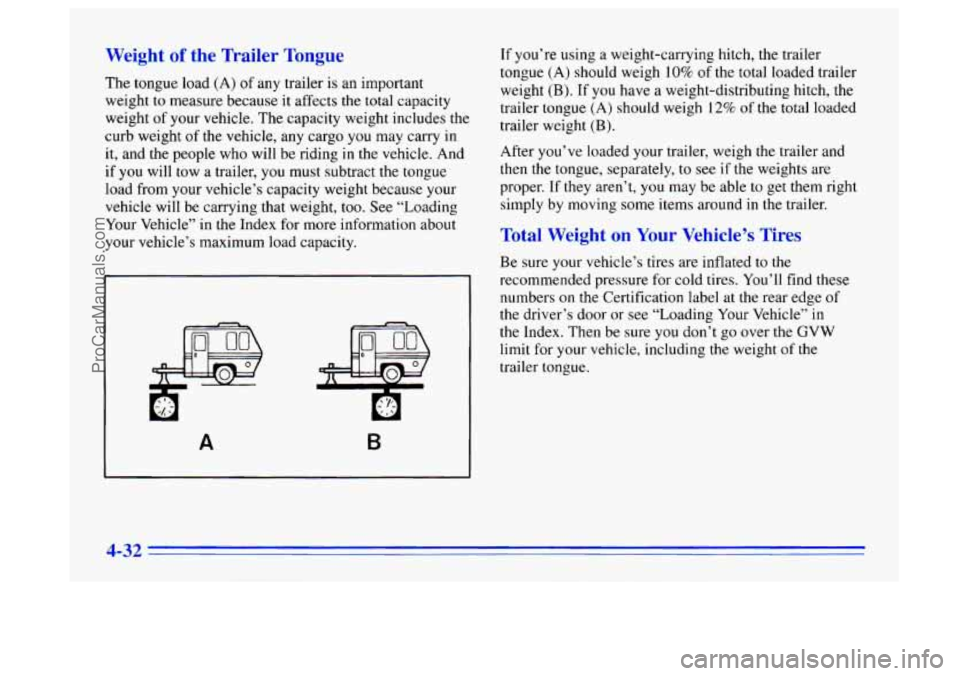
Weight of the Trailer Tongue
The tongue load (A) of any trailer is an important
weight to measure because it affects the total capacity
weight
of your vehicle. The capacity weight includes the
curb weight
of the vehicle, any cargo you may carry in
it, and the people who will be riding in the vehicle. And
if you will tow a trailer, you must subtract the tongue
load from your vehicle’s capacity weight because your
vehicle will be carrying that weight, too.
See “Loading
Your Vehicle”
in the Index for more information about
your vehicle’s maximum load capacity.
A
If you’re using a weight-carrying hitch, the trailer
tongue
(A) should weigh 10% of the total loaded trailer
weight
(€3). If you have a weight-distributing hitch, the
trailer tongue
(A) should weigh 12% of the total loaded
trailer weight
(B).
After you’ve loaded your trailer, weigh the trailer and
then the tongue, separately, to
see if the weights are
proper. If they aren’t, you may be able to get them right
simply by moving some items around in the trailer.
Total Weight on Your Vehicle’s Tires
Be sure your vehicle’s tires are inflated to the
recommended pressure for cold tires. You’ll find these
numbers
on the Certification label at the rear edge of
the driver’s door or see “Loading Your Vehicle”
in
the Index. Then be sure you don’t go over the GVW
limit for your vehicle, including the weight of the
trailer tongue.
4-32
ProCarManuals.com
Page 163 of 340
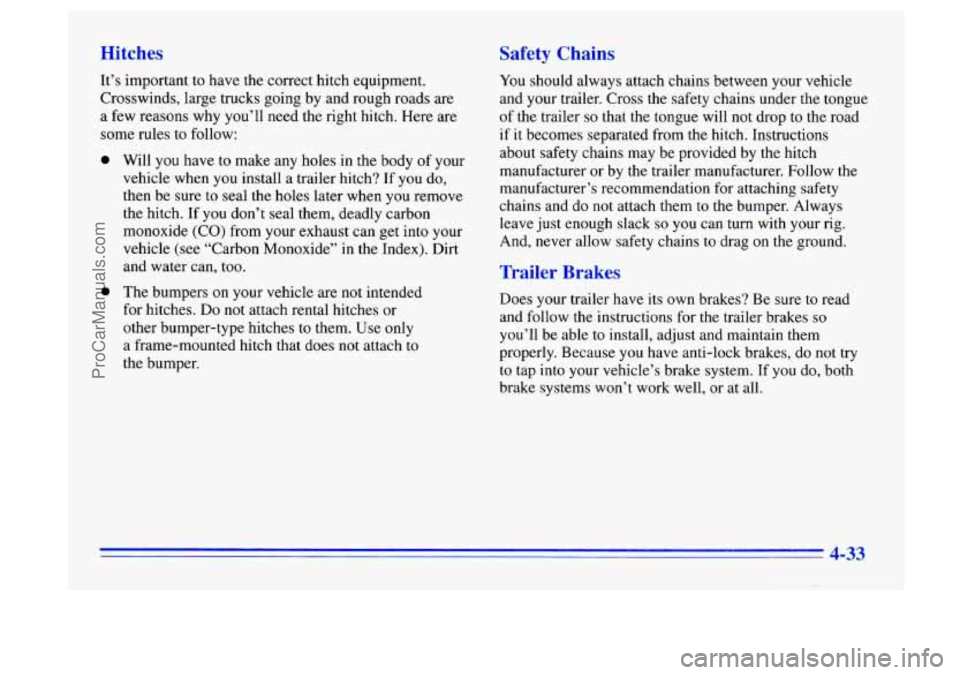
Hitches Safety Chains
You should always attach chains between your vehicle
and your trailer. Cross the safety chains under the tongue
of the trailer
so that the tongue will not drop to the road
if it becomes separated from the hitch. Instructions
about safety chains may be provided by the hitch
manufacturer or by the trailer manufacturer. Follow the
manufacturer’s recommendation for attaching safety
chains and do not attach them to the bumper. Always
leave just enough slack so you can turn with your rig.
And, never allow safety chains to drag on the ground.
It’s
important to have the correct hitch equipment.
Crosswinds, large trucks going by and rough roads are a few reasons why you’ll need the right hitch. Here are
some rules to follow:
0
0
Will you have to make any holes in the body of your
vehicle when
you install a trailer hitch? If you do,
then be sure
to seal the holes later when you remove
the hitch. If you don’t seal them, deadly carbon
monoxide (CO) from your exhaust can get into your
vehicle (see “Carbon Monoxide” in the Index). Dirt
and water can, too.
The bumpers
on your vehicle are not intended
for hitches. Do not attach rental hitches
or
other bumper-type hitches to them. Use only
a frame-mounted hitch that does
not attach to
the bumper.
Trailer Brakes
Does your trailer have its own brakes? Be sure to read
and follow the instructions for the trailer brakes
so
you’ll be able to install, adjust and maintain them
properly. Because you have anti-lock brakes, do not try
to tap into your vehicle’s brake system.
If you do, both
brake systems won’t work well, or at all.
4-33
ProCarManuals.com